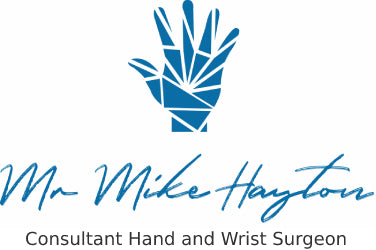Trigger Finger / Thumb
Mr Mike Hayton
FRCS(Trauma and Orth) FFSEM (UK)
Consultant Orthopaedic Hand Surgeon

Other common names
None
Who does it affect?
Anyone, from babies to the very elderly
Why does it occur?
The tendons in the fingers that cause the fingers to bend (flex) may develop a nodule.
Finger flexor tendons travel in a slippy sheath along the finger, and the tendon slides in and out as the finger bends and straightens. The sheath lubricates the tendon and also prevents bowstringing of the tendons as the finger bends. In cases of trigger finger a nodule develops on the tendon. As the finger bends the nodule passes out of the sheath into the palm. As the finger straightens the nodule attempts to pass back into the sheath but becomes locked at its mouth. Preventing the finger from fully straightening. The finger may be forcibly straightened with a click but should be avoided.
Symptoms
Locking of the finger/ thumb. The fingers fully bend (flex) but on attempting to straighten they lock with a bend. Occasionally the symptoms are not as dramatic as this but the patient may notice clicking or even feel a nodule at the base of the finger/thumb.
Clinical Examination
A classic trigger finger/thumb is diagnostic. A nodule may be felt at the base of the finger/thumb.
Occasionally the finger/thumb is locked in a flexed position.
Here is a short video clip of one of my patient's demonstrating classic triggering.
Investigations
Usually none. Occasionally an ultrasound scan may be of benefit in cases of uncertainty.
Non-operative treatment
Babies that are affected have a 90% chance of the condition settling by 12 months old. If it fails to settle after this and is troublesome then surgery is indicated. Also if the thumb is locked in a child then this should be operated on early to prevent joint problems
In adults, a steroid injection into the sheath may lubricate and also damp down the inflammation. Steroid injections can be repeated once. Further attempts may damage the tendon and surgery would be advised after one or two failed injections.
Operative treatment
The surgery is a day case procedure usually under local anaesthetic and takes about 10 minutes. A tourniquet is not often needed.
Local anaesthetic is infiltrated under the skin in line with the incision at the base of the digit on its flexor (front) surface. Once numb the skin is incised and then the underlying fat is retracted. Care is taken not to injure nerves and blood vessels to the digit. At the base of the wound is the flexor sheath. The mouth of this structure (A1 pulley) needs to be released to allow the tendon and its nodule to glide in and out without catching. The nodule is not removed. The skin is sutured with absorbable sutures and a bulky dressing is applied.
Post-operative rehabilitation
The patient is fit to go home soon after the operation. The anaesthetic will wear off after approximately 6 hours. Simple analgesia usually controls the pain and should be started before the anaesthetic has worn off. The hand should be elevated as much as possible for the first 5 days to prevent the hand and fingers swelling. Gently bend and straighten the fingers from day 1. My preference is to remove the dressing at 2 days. The wound is cleaned and redressed with a simple dressing. Avoid forced gripping or lifting heavy objects for 2-3 weeks. The sutures dissolve at about 2 weeks. You should notice an improvement in symptoms within a few days but the final result may be realised at about 3 months.
Click here to download a pdf of post operative instructions
Return to activities of daily living
It is my advice to keep the wound dry until the wound heals at about 7-10days.
Return to driving:
The hand needs to have full control of the steering wheel and left hand the gear stick. It is probably advisable to delay returning to driving for a few days.
Return to work:
Everyone has different work environments.
Returning to heavy manual labour should be prevented for approximately 4 to 6 weeks. Early return to heavy work may cause the tendons and nerve to scar into the released ligament. Please ask your surgeon for advice on this.
Complications
Overall, greater than 95% are happy with the result. However complications can occur.
There are complications specific to Trigger Finger release and also general complications associated with hand surgery.
General complications:
Please click here for general complications
Specific complications:
Failure to completely resolve the symptoms (approximately 1% - this may be due to failure to completely release the area that is catching). This should be rare but may be released again.
Injury to the blood vessels and nerves to the finger (less than 1%). This may leave one side of the finger numb. If this occurs, the wound should be explored and if injured, the nerve repair.
